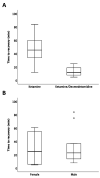Rapid Recovery and Short Duration Anesthesia after Low Dose Ketamine and High Dose Dexmedetomidine in Rhesus Macaques (Macaca mulatta)
- PMID: 33731246
- PMCID: PMC8145129
- DOI: 10.30802/AALAS-JAALAS-20-000112
Rapid Recovery and Short Duration Anesthesia after Low Dose Ketamine and High Dose Dexmedetomidine in Rhesus Macaques (Macaca mulatta)
Abstract
Anesthesia in rhesus macaques is required for many procedures. Although ketamine is the backbone of most anesthetic protocols, tolerance to the drug can develop, resulting in the need for higher doses to provide sufficient restraint. Combination with other drugs, such as α-agonists, can be ketamine-sparing, providing for sufficient restraint at lower ketamine doses. In addition, because α-agonists are reversible, recovery from anesthesia has the potential to be much shorter. We hypothesized that use of a low dose of ketamine with a high dose of dexmedetomidine, an α2 receptor selective agonist, in male and female rhesus macaques less than 15 y of age would provide adequate anesthesia for short procedures and that recovery would be faster than in macaques given a higher dose of ketamine (10 mg/kg) alone. We found that the combination, in conjunction with atipamezole for reversal, provided smooth induction of anesthesia and significantly shorter recovery time than did ketamine alone, with no significant effects of sex. The combination of low dose ketamine and high dose dexmedetomidine also provided a 30-min window of anesthesia with analgesia sufficient for mild to moderately painful procedures.
Figures


Similar articles
-
Atipamezole reverses ketamine-dexmedetomidine anesthesia without altering the antinociceptive effects of butorphanol and buprenorphine in female C57BL/6J mice.J Am Assoc Lab Anim Sci. 2014 Nov;53(6):675-83. J Am Assoc Lab Anim Sci. 2014. PMID: 25650975 Free PMC article.
-
Comparison of Alfaxalone-Midazolam, Tiletamine-Zolazepam, and KetamineAcepromazine Anesthesia during Plethysmography in Cynomolgus Macaques (Macaca fascicularis) and Rhesus Macaques (Macaca mulatta).Comp Med. 2022 Aug 1;72(4):248-256. doi: 10.30802/AALAS-CM-22-000010. Epub 2022 Jun 30. Comp Med. 2022. PMID: 35772936 Free PMC article.
-
Comparison of xylazine-ketamine and dexmedetomidine-ketamine anesthesia in captive Formosan serows (Capricornis swinhoei).J Zoo Wildl Med. 2014 Dec;45(4):787-91. doi: 10.1638/2013-0291.1. J Zoo Wildl Med. 2014. PMID: 25632664 Clinical Trial.
-
Role of novel drugs in sedation outside the operating room: dexmedetomidine, ketamine and remifentanil.Curr Opin Anaesthesiol. 2014 Aug;27(4):442-7. doi: 10.1097/ACO.0000000000000086. Curr Opin Anaesthesiol. 2014. PMID: 24762954 Review.
-
Strategies and experimental models for evaluating anesthetics: effects on the developing nervous system.Anesth Analg. 2008 Jun;106(6):1643-58. doi: 10.1213/ane.ob013e3181732c01. Anesth Analg. 2008. PMID: 18499593 Review.
References
MeSH terms
Substances
LinkOut - more resources
Full Text Sources
Other Literature Sources
Medical

